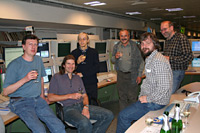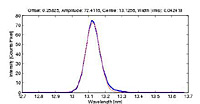 |
|||||||||||
|
|||||||||||
|
|||||||||||
|
Shortest wavelength generated with DESY’s pilot facility for the future European XFEL When Albrecht Wagner, Chairman of the DESY Directorate, opened his mailbox in the morning of 27 April and found an email about FLASH’s 13.1-nm success, he replied immediately: "This is exciting and fantastic news! Congratulations to the entire team!" FLASH, DESY’s pilot facility for the future European XFEL, produced the shortest wavelength yet. This success was celebrated with a party in DESY’s accelerator control room the night before at 22:10 h. Already after three hours, when the superconducting TESLA Test Facility Linac, equipped with five accelerator modules, reached the designated energy of 700 MeV, the electron bunches that traversed the undulator emitted laser flashes with a wavelength of only 13.1 nm (there’s a plot from the logbook for those who don’t believe it). This is an important step on the way to reach the design value of 6 nm planned for the FLASH facility. With the sixth module which will be installed in the second quarter of 2007, it will be possible to accelerate the electron bunches to 1 GeV and to generate wavelengths of 6 nm. FLASH, which stands for Free-Electron Laser in Hamburg, was commissioned in 2004 and has been used for research with shortwave ultraviolet radiation since 2005. The facility was first called VUV-FEL (vacuum ultraviolet free-electron laser) and was renamed FLASH in April 2006. The 260-m facility is being extended step by step. In its final configuration, it will generate X-ray radiation down to a wavelength of 6 nm. Until the year 2009, FLASH will then be the only free-electron laser in the world for radiation in the soft X-ray region. Besides being used for research with the generated radiation, FLASH also serves as a pilot facility for the planned European X-ray free-electron laser XFEL: its operation provides major insights that will benefit the future machine, which will generate even shorter wavelengths down to 0.085 nm and will take up operation in 2013. At the same time, scientists and engineers can use the FLASH facility to continue development work for International Linear Collider. -- Petra Folkerts, DESY PR/FEL |
|||||||||||
| © International Linear Collider |

